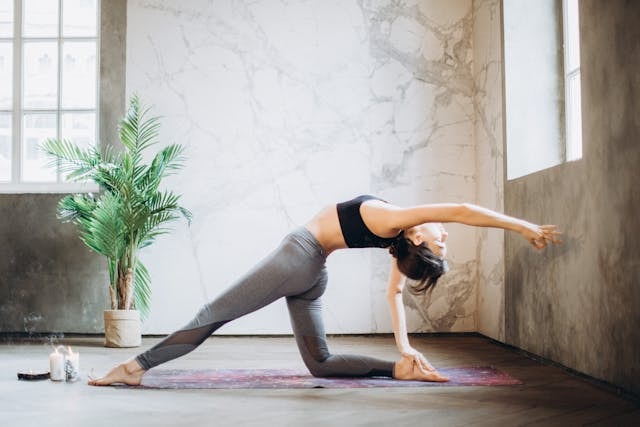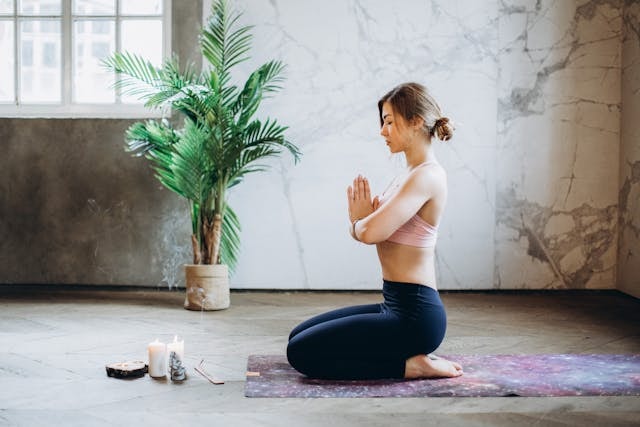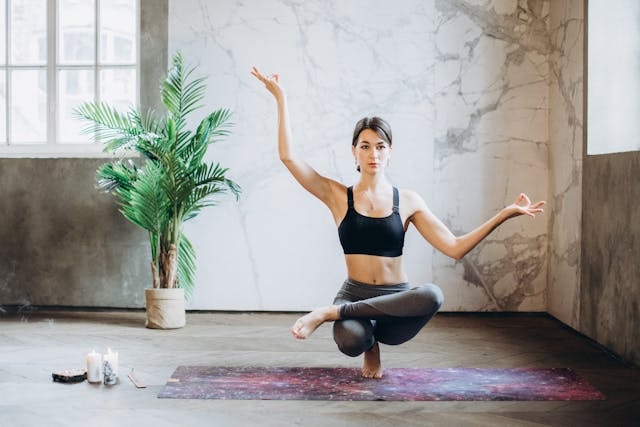Can You Learn Yoga Online? Exploring the Benefits and Challenges

Have you ever wondered if you could master yoga without stepping into a physical studio? Well, you’re not alone. With everything going digital these days, online yoga classes have also leaped onto the virtual stage, becoming a hot favorite for fitness enthusiasts around the globe.
It all kicked off when, thanks to recent global events—think lockdowns and social distancing—many of us were pushed to rethink how we stay fit. Traditional yoga practices, with their soothing music and incense-scented rooms, were swapped for living rooms and makeshift home yoga studios. This shift wasn’t just a temporary adjustment but a real eye-opener to the potential of online learning in yoga.
Online yoga classes and yoga teachers have surged in popularity, inviting yogis and novices alike to roll their mats before their screens and start practicing yoga. This digital transformation in the wellness and fitness world has shown us that maybe, just maybe, learning yoga online isn’t just a makeshift solution but a valid, flexible option to traditional studio classes.
But how does it compare to the real deal, and what are the nitty-gritty details of embracing yoga through a screen?
Let’s explore online yoga, its sparkling benefits, and the hurdles you might not see coming.
Benefits of Online Yoga
Accessibility and Variety
Ever felt like you’re missing out because the local yoga studios don’t offer that quirky, niche yoga style you stumbled upon online?
Well, online yoga platforms and online yoga classes are a game-changer. With just a few clicks, you can explore an expansive world of personal practice that spans countless styles, from the slow, meditative Yin Yoga to the vigorous, sweat-inducing power of Ashtanga. And it’s not just about styles; the variety of yoga teachers available can enrich your practice.
Whether looking for a guru from India to deepen your spiritual connection or a high-energy instructor from California to boost your fitness, online yoga breaks down geographical barriers. It brings a diverse range of instructors right to your living room.
You’re never short of options or inspiration thanks to resources like YOGI TIMES and The Culture-ist.
For a deeper understanding, you can check out how others have navigated the transition to digital learning through resources like can you really learn yoga online, which delve into personal experiences and expert insights.
Convenience and Flexibility

Imagine doing a sunrise live yoga class on your schedule, perhaps even in your pajamas. This is the convenience that online yoga offers. There is no need to commute, no rushing to make a class after work, and no packing a giant bag for the day.
Online yoga fits seamlessly into your lifestyle, allowing you to practice yoga whenever and wherever you want, be it during a lunch break or late at night when the world quiets down.
Platforms highlighted by YOGI TIMES and Yogalian show that whether you have a packed schedule or unpredictable work hours, online yoga provides the flexibility to maintain your practice on your terms.
This convenience saves time and makes it easier to commit to a consistent yoga practice.
Cost-Effectiveness
Think about all the times you’ve paid for a full month at a yoga class and only made it to a handful of classes. Online yoga classes are a total game changer in this respect. Without the overhead costs of physical space, online classes often come at a fraction of the price of traditional studios, be it group classes or personal classes.
And let’s not forget the savings on travel and those incidental expenses—no more gas money or public transport fares, and no temptation to buy another smoothie on your way home.
According to insights from ProsourceFit, the economic benefits of switching to online classes can add up quickly, making it a budget-friendly option for everyone, whether you’re a yoga newbie or a seasoned practitioner.
Personalized Learning
One of the coolest things about online yoga is that you call the shots. If a pose or sequence moves too fast or seems too complicated, you can hit pause, rewind, and watch it again pre-recorded.
This level of pre-recorded control makes it easier to master difficult techniques at your own pace, enhancing your overall full-length learning experience. As highlighted by YOGI TIMES, this personalized instructor’s approach accommodates different learning speeds and styles, making yoga more accessible and enjoyable for everyone.
Community and Support

Who says you need to be in the same room to feel connected? Online yoga platforms are smashing this myth by creating vibrant communities where you can share experiences, challenges, and triumphs.
Through forums, live chats, and interactive instructor sessions, these virtual communities offer a sense of belonging, more flexibility, and support that rivals traditional studios.
YOGI TIMES and The Culture-ist note that these platforms connect you with fellow yogis globally and provide emotional and motivational support, making the yoga journey less solitary and much more fulfilling.
Challenges of Learning Yoga Online
Lack of Personal Guidance
One major hurdle of diving into online yoga classes through your screen? The absence of a yoga teacher to physically guide your poses. While online yoga teachers do their best to explain and demonstrate the position of your body, they can’t come over and adjust your alignment.
This gap can sometimes lead to incorrect poses, which not only hinders the effectiveness of your yoga practice but could also increase the risk of injury. As Ekhart Yoga points out, nothing replaces the hands-on adjustments and immediate feedback you get in a live class setting.
This is especially crucial for beginners who are still learning the ropes and may be unable to tell if they’re performing poses correctly just by watching a video.
Self-Motivation Required

Let’s face it: keeping yourself motivated without the external push of having to attend a scheduled yoga class can be tough. When you’re practicing yoga online, it’s all on you to roll out your mat and get started, which can be a real challenge when you feeling less than inspired.
Ekhart Yoga highlights this as a significant obstacle; without the physical presence of a yoga teacher and other students and the commitment of a prepaid class, it’s easy to let your yoga practice slide down your list of priorities.
Online yoga demands self-discipline and motivation, qualities that can take time to cultivate for those used to structured class environments.
Technology Dependence
In the digital age, even yoga isn’t free from tech hiccups. Relying on technology means that your flow can be only as smooth as your internet connection. Imagine being mid-pose and suddenly freezing—not because of your incredible control, but due to a spotty connection. According to Ekhart Yoga, this is just the tip of the iceberg. Not everyone has the luxury of a quiet, spacious spot at home, and the need for personal devices like a smartphone or laptop can exclude those on a tight budget.
These technological demands can make online yoga less accessible and more frustrating, especially when you’re all set to go and technology says no.
Quality and Credibility of Content
With the vast ocean of online yoga classes available, not all are created equal. The quality of content can vary dramatically, from professionally produced videos to someone’s poorly lit living room session. Experts stress the importance of doing your homework—checking the credentials and qualifications of online yoga instructors is a must. It’s easy to be misled by someone with a great social media presence but little teaching expertise.
Ensuring that you’re learning from a qualified instructor enhances your yoga journey and safeguards your physical well-being from poorly instructed poses.
Tips for a Successful Online Yoga Experience
Choosing the Right Platform
Not all yoga platforms are built the same. To ensure you’re getting the best possible online yoga experience, choosing a reputable one is crucial. Look for platforms featuring certified instructors—those who know their downward dog from their crow pose—and that boast positive reviews from other users. Websites like Yogalian can be great resources for filtering through myriad options.
A good rule of thumb is to check if the platform offers a range of yoga styles and levels, which indicates a broad approach to yoga practice.
Remember, the right platform can make all the difference in how effectively you can follow and benefit from your sessions.
Creating an Optimal Home Environment

Setting up the right environment at home can significantly enhance your yoga practice. Start by finding a quiet corner where you won’t be disturbed—this could even be a small section of your bedroom or living room.
Lay down your mat in a way that gives you ample space to move without bumping into furniture.
Consider incorporating elements that soothe the senses to elevate your practice, like candles for soft lighting or cushions for added comfort. YOGI TIMES suggests these little touches can transform a mundane space into a tranquil sanctuary, making your yoga experience more authentic and enjoyable.
Engaging with the Community
Don’t let the screen fool you; the online yoga community is as real and vibrant as any studio! Engaging with this community through virtual classes and live-streamed sessions can enhance your motivation and deepen your practice.
Platforms like The Culture-ist show how interactive classes offer a sense of togetherness and accountability that solo sessions can’t match.
Plus, this engagement provides an opportunity for immediate feedback from instructors and fellow yogis, helping you refine your poses and techniques. So, dive into the chat boxes, participate in discussions, and maybe join a live session. It’s a fantastic way to feel connected and supported on your yoga journey.
Frequently Asked Questions
Is online yoga as effective as studio yoga?
Yes, online yoga classes can be just as effective as traditional yoga studio sessions for many people. They offer flexibility, various styles and instructors, and the convenience of practicing yoga at home. While it lacks personal adjustments from yoga teachers, many find the trade-offs, like being able to choose from global teachers and different styles, worthwhile.
What are the main challenges of online yoga?
The main challenges include:
The lack of personal guidance can lead to incorrect poses and an increased risk of injury.
There is a need for self-motivation as there are no scheduled yoga classes to attend.
Technology dependency might disrupt sessions due to connectivity issues.
The variability in the quality of online yoga classes.
How do I choose the right online yoga platform?
Look for platforms that feature certified yoga instructors and have good user reviews. Also, consider the variety of yoga styles and levels they offer. Platforms that provide a broad approach are usually better choices. Resources like Yogalian can help you filter through the options available.
Can I learn yoga online if I am a beginner?
Absolutely! Online yoga is suitable for beginners and offers personalized learning where you can pause, replay, and focus on specific class parts at your own pace. However, beginners should be particularly cautious about choosing platforms with well-qualified instructors to minimize the risk of injury.
How can I make my online yoga practice more engaging?
Engage with the online yoga community through forums, live chats, and interactive sessions. These platforms help provide motivation, support, and a sense of belonging. Participating in live-streamed classes can also enhance your practice by allowing real-time feedback and interaction with yoga teachers and fellow yogis.
Conclusion
Learning yoga online is more than just a convenience; it’s a bridge to a vast world of wellness you can explore from the comfort of your home. The journey offers incredible benefits like flexibility, variety, and cost-effectiveness while posing challenges like self-motivation and the absence of in-person guidance.
As you consider stepping onto this virtual mat, weigh these aspects carefully. Remember, the right platform, a conducive home environment, and an engaging community can make all the difference. Whether a seasoned yogi or a curious beginner, online yoga offers a valuable pathway to maintain and enhance your practice. Why not give it a try and see how it unfolds for you?
